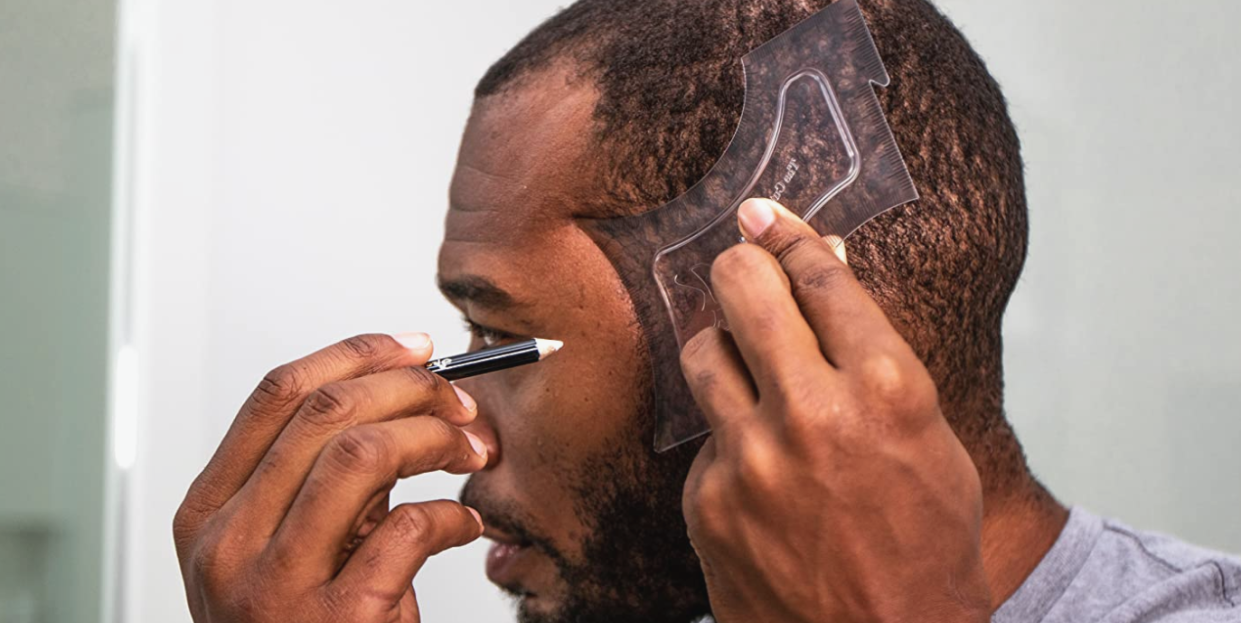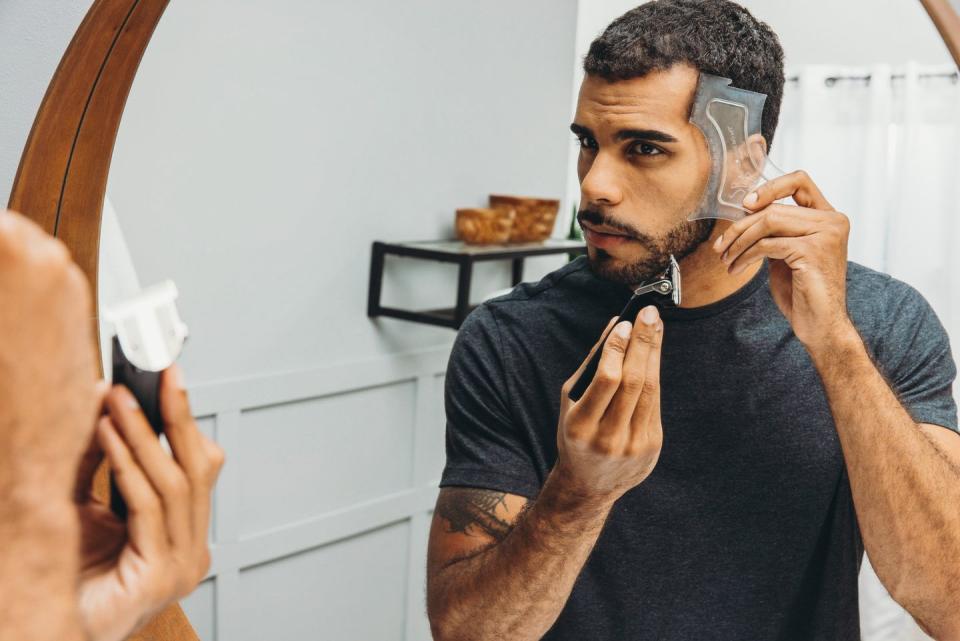The Incredible Story Behind The Cut Buddy, One of Shark Tank's Biggest Successes

- Oops!Something went wrong.Please try again later.
Shop Small is a bi-weekly series highlighting small business owners from diverse backgrounds. This series aims to go deeper than your typical product roundup, diving into the inspirational stories behind some of our favorite brands. By taking a behind-the-scenes look at how their shops came to be and highlighting the products they (and their shoppers!) love, we hope to put a deserving spotlight on these marginalized business owners.
The story of The Cut Buddy is a simple one. At 13 years old, Joshua Esnard was tired of getting buzz cuts from his father, and finally decided to try shaping up his own hairline. "If my father can do it, I can too," he thought at the time. Esnard soon learned that wasn’t the case; he ended up with bald spots and uneven lines.
But practice makes perfect, right? Wrong. Esnard’s determination didn’t make his cuts better, but it did help give him the idea to create his own at-home shaping tool. Tired of sporting cheetah spots and a pushed-back hairline, Esnard grabbed torn pizza boxes and detergent bottles to create a stencil for shaping hairlines.
“I found anything firm that I could use to make a stencil, and I put it against my head and ran the trimmer as sporadically as I could without my skill set of barbering,” he says. "Those template tools allowed me to end up with a lineup, an edge-up, that was near barber quality.”
For 15 years, Esnard used this template, customizing the stencil occasionally to fit his head size. He never considered monetizing the product until his wife said to him: “You never finish what you start.” Those words drove him to pick up a journal full of business ideas and aspirations from his childhood, and turn to the first page, which reminded him of the very first invention he made — the shaping tool.
The next day, Esnard went to an attorney, acquired a patent for the shaping tool, and began using his credit cards and outsourcing family donations to jumpstart his company. It was 2016, almost two decades since he first invented the pizza-box-turned-barber-stencil, but he was finally ready to cash out and live up to his aspirations of being a business owner.
Was it easy? No, but the payoff was worth it. Read on to learn more about Esnard's business, his appearance on Shark Tank and his journey as a Black entrepreneur.
The Road to Funding
Almost every small business owner struggles with securing funding, and Esnard was no different; he maxed out his credit cards and savings account when getting The Cut Buddy off the ground in January 2016.
But three months later, a Hail Mary came through. “By March 5, we went viral with 12 million views on a video from one of our affiliates,” he says. “[We] went viral on Facebook and YouTube and that resulted in becoming a bestseller on Amazon and sold us a lot of products, which led to the Shark Tank invite.”
Esnard credits Shark Tank and Daymond John, one of the show's judges, for The Cut Buddy's success. With John’s help, Esnard earned a licensing deal and collaboration with a major clipper company that helped the shaping tool reach big retailers.
But 2020 also had a major impact, with more and more brands looking to diversify their inventory as calls for racial justice rang through the world. “Amazon, Walmart, Target and a lot of brands were now focusing on telling those stories that didn't have a voice as the companies that were primarily on the shelves were white-led or white-owned,” he says. “There was no real minority stake in those companies. That gave us an opportunity to present our products to Walmart and Target. They took us on quickly.”

Product Development
At first, the tool was used primarily to shape the angles of sideburns and hairlines. But as Esnard used it more frequently, he started to experiment. “I realized that I needed to work on my angles and straight edges so that it fits everybody's head,” he says. “So, that's where the product became more of a multi-curve, multi-sided tool that I ended up improving.”
For 15 years, he accidentally conducted the research and development process, which saved time and cut costs when he began mass-producing the shaping tool. First, he used plastic folders and cut them into a stencil, which he says worked the best. But sometimes, he would forget to bring the tool on vacation and had to improvise. Enter the next iteration: a Bud Light box.
“I tried to use a pizza box, but it didn't bend right,” he says. “Then, I used the Bud Light box and I cut a shape out. Then I started trying harder with more flexible plastics like detergent bottles.”
Once he knew hard plastics were the perfect material for the stencil, he filed the patent. Thanks to his father-in-law, a CAD engineer, he was able to turn his idea into an actual product design, so he could construct his prototype.
Of course, the final tool has been tweaked a few times since 2016 (the company has released more shaping tools such as trimmers, clippers, and shavers and plans to introduce products specifically designed for women with short hair), but its original purpose remains the same: the shaping tool is used to help people cut hair, whether that’s a single mother shaping her son’s lineup or a disabled veteran struggling to hold a razor.
Lessons Learned
Esnard has learned so much since launching The Cut Buddy in 2016. The most important one, he says, is to believe in yourself because no one else will. Many were flabbergasted by how Esnard went from music producer management to becoming a struggling entrepreneur. They didn’t see the validity in his dreams, he says. “You need to have your own conviction and belief in yourself to take the jump to do something — you don't need other people's approval to be an inventor,” he says.
The second lesson is more tactical: work on your salesmanship. Family and friends might not believe in your product, and chances are investors won't either, so you have to make them, he says.
Thirdly, he recommends moving at your own pace and not looking back. Esnard remembers his mentor saying this phrase: “A horse never looks backward.” Sure, they’ll be competitors and copycats, but he says it's important to stay focused on your business goals. “I just have to be ahead of the game, and innovate based on wanting to help people with ergonomics, disabilities and struggles," he says. "Don't worry about what they're creating."
As Esnard's story proves, sometimes taking a risk is truly worth the reward.
You Might Also Like

